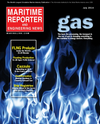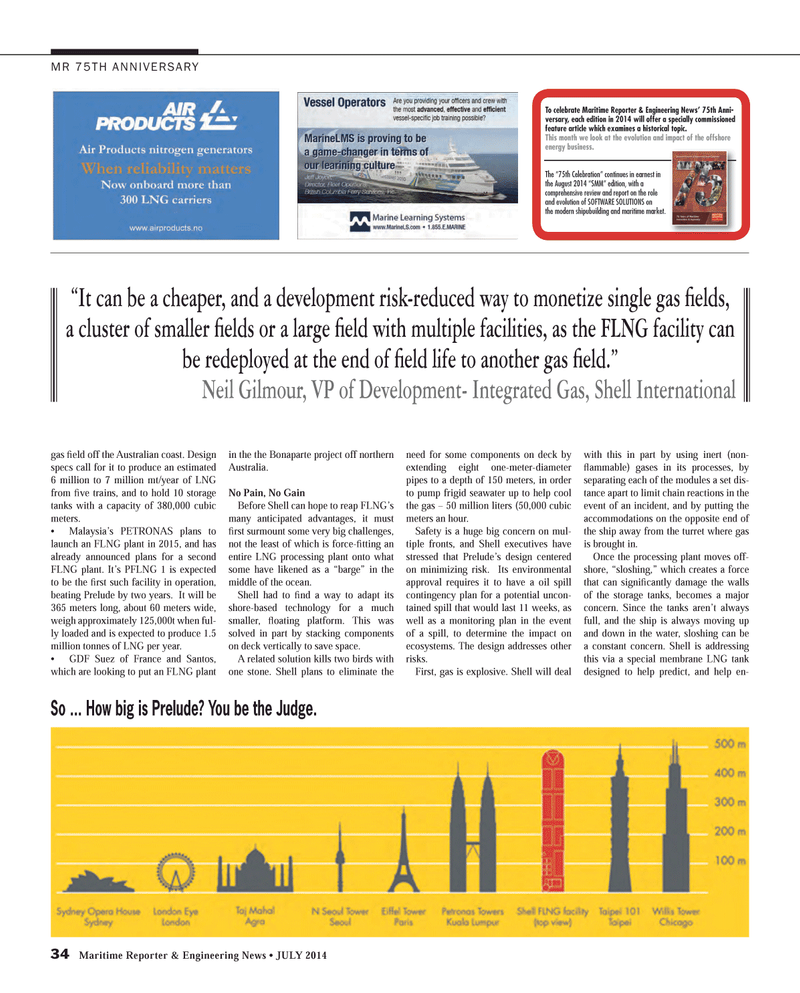
Page 34: of Maritime Reporter Magazine (July 2014)
Offshore Energy Structures & Systems
Read this page in Pdf, Flash or Html5 edition of July 2014 Maritime Reporter Magazine
34 Maritime Reporter & Engineering News • JULY 2014
MR 75TH ANNIVERSARY gas fi eld off the Australian coast. Design specs call for it to produce an estimated 6 million to 7 million mt/year of LNG from fi ve trains, and to hold 10 storage tanks with a capacity of 380,000 cubic meters. • Malaysia’s PETRONAS plans to launch an FLNG plant in 2015, and has already announced plans for a second
FLNG plant. It’s PFLNG 1 is expected to be the fi rst such facility in operation, beating Prelude by two years. It will be 365 meters long, about 60 meters wide, weigh approximately 125,000t when ful- ly loaded and is expected to produce 1.5 million tonnes of LNG per year. • GDF Suez of France and Santos, which are looking to put an FLNG plant in the the Bonaparte project off northern
Australia.
No Pain, No Gain
Before Shell can hope to reap FLNG’s many anticipated advantages, it must fi rst surmount some very big challenges, not the least of which is force-fi tting an entire LNG processing plant onto what some have likened as a “barge” in the middle of the ocean.
Shell had to fi nd a way to adapt its shore-based technology for a much smaller, fl oating platform. This was solved in part by stacking components on deck vertically to save space.
A related solution kills two birds with one stone. Shell plans to eliminate the need for some components on deck by extending eight one-meter-diameter pipes to a depth of 150 meters, in order to pump frigid seawater up to help cool the gas – 50 million liters (50,000 cubic meters an hour.
Safety is a huge big concern on mul- tiple fronts, and Shell executives have stressed that Prelude’s design centered on minimizing risk. Its environmental approval requires it to have a oil spill contingency plan for a potential uncon- tained spill that would last 11 weeks, as well as a monitoring plan in the event of a spill, to determine the impact on ecosystems. The design addresses other risks.
First, gas is explosive. Shell will deal with this in part by using inert (non- fl ammable) gases in its processes, by separating each of the modules a set dis- tance apart to limit chain reactions in the event of an incident, and by putting the accommodations on the opposite end of the ship away from the turret where gas is brought in.
Once the processing plant moves off- shore, “sloshing,” which creates a force that can signifi cantly damage the walls of the storage tanks, becomes a major concern. Since the tanks aren’t always full, and the ship is always moving up and down in the water, sloshing can be a constant concern. Shell is addressing this via a special membrane LNG tank designed to help predict, and help en-
So ... How big is Prelude? You be the Judge. “It can be a cheaper, and a development risk-reduced way to monetize single gas fi elds, a cluster of smaller fi elds or a large fi eld with multiple facilities, as the FLNG facility can be redeployed at the end of fi eld life to another gas fi eld.”
Neil Gilmour, VP of Development- Integrated Gas, Shell International
To celebrate Maritime Reporter & Engineering News’ 75th Anni- versary, each edition in 2014 will offer a specially commissioned feature article which examines a historical topic.
This month we look at the evolution and impact of the offshore energy business.
The “75th Celebration” continues in earnest in the August 2014 “SMM” edition, with a comprehensive review and report on the role and evolution of SOFTWARE SOLUTIONS on the modern shipubuilding and maritime market.
MR #7 (32-41).indd 34 7/1/2014 10:08:49 AM

 33
33

 35
35
